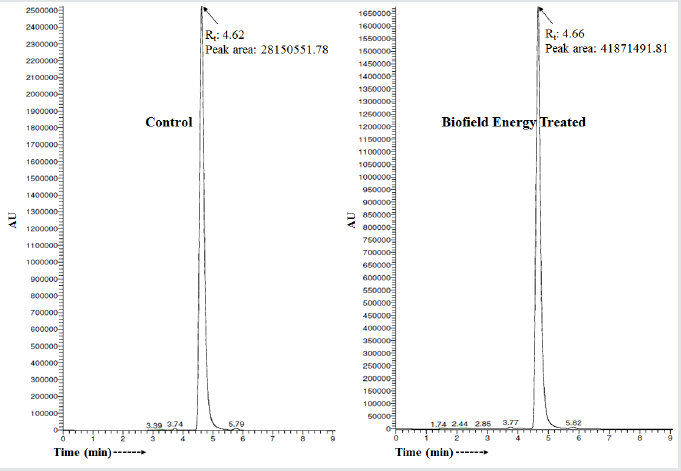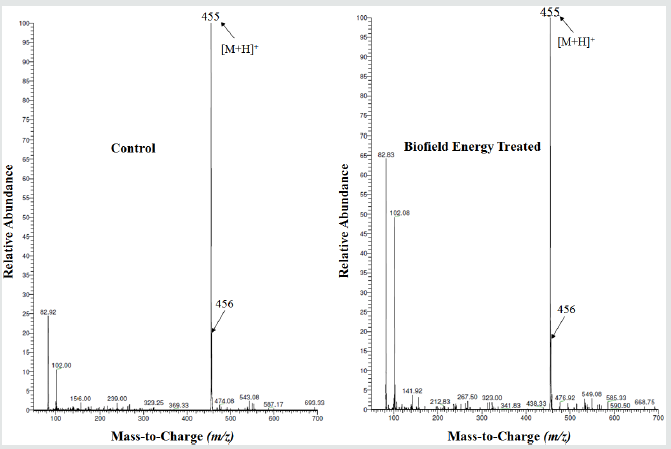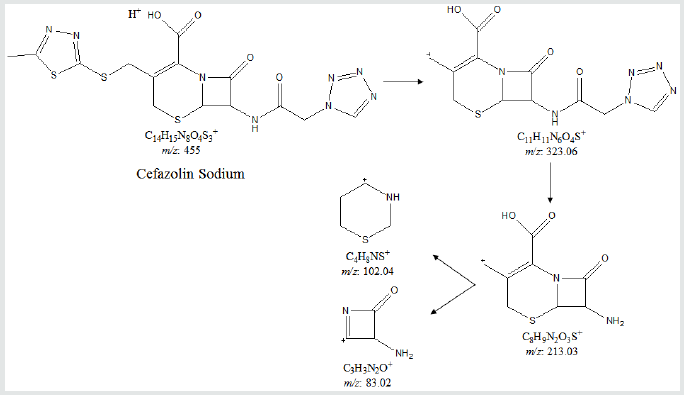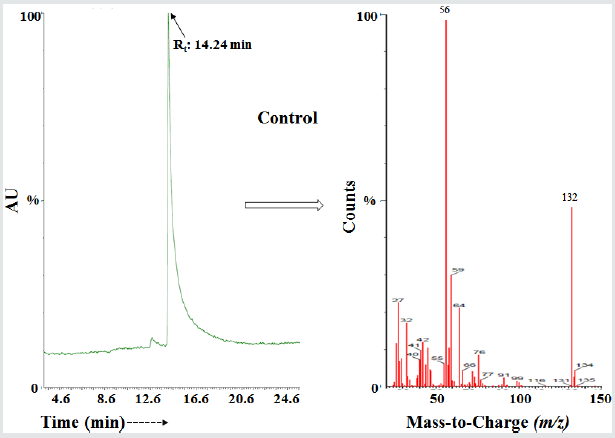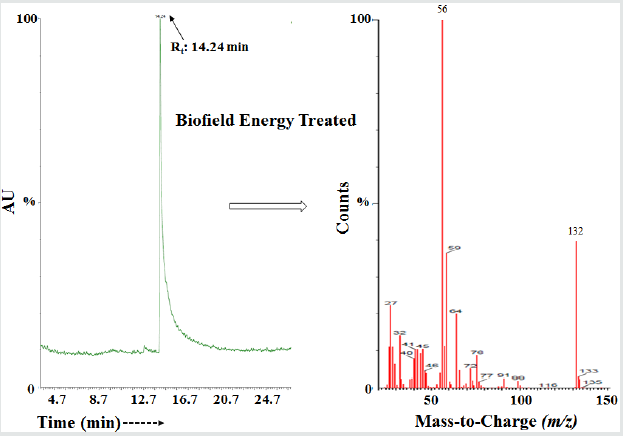
Lupine Publishers Group
Lupine Publishers
Menu
ISSN: 2637-4609
Research Article(ISSN: 2637-4609) 
Evaluation of the LC-MS and GC-MS based Isotopic Abundance Ratio of Consciousness Energy Healing Treated Cefazolin Sodium Volume 5 - Issue 1
Dahryn Trivedi1, Mahendra Kumar Trivedi1, Alice Branton1 and Snehasis Jana2*
- 1Trivedi Global Inc, Henderson, USA
- 2Trivedi Science Research Laboratory Pvt. Ltd, Thane (W), India
Received: January 21, 2021; Published: February 03, 2021
*Corresponding author: Snehasis Jana, Trivedi Science Research Laboratory Pvt. Ltd., Thane (W), India
DOI: 10.32474/AOICS.2021.05.000202
Abstract
Cefazolin sodium is a broad-spectrum antibiotic, which is used for the treatment of a number of bacterial infections. In this study the impact of the Trivedi Effect®-Biofield Energy Healing Treatment on the isotopic abundance ratio of cefazolin sodium using LC-MS and GC-MS spectroscopy. The test sample cefazolin sodium powder was divided into two parts and termed as control and treated sample. The control test sample did not treat with the Consciousness Energy Healing Treatment. However, the treated test sample received the Consciousness Energy Healing Treatment remotely by the renowned Biofield Energy Healer, Dahryn Trivedi. The LC-MS spectra of both the samples at the retention time (Rt) 4.6 minutes exhibited the mass of the protonated molecular ion peak at m/z 455 [M+Hs. The peak area of the treated cefazolin was significantly increased by 48.74% compared to the control sample. The LC-MS based isotopic abundance ratio of PM+1/PM (2H/1H or 13C/12C or 15N/14N or 17O/16O or 33S/32S) in the treated cefazolin was significantly increased by 33.54% compared with the control sample. Thus, 13C, 2H, 15N, 17O and 33S contributions from (C14H15N8O4S3)+ to m/z 456 in the treated sample were significantly increased compared with the control sample. The GC-MS peak intensities of the treated sample at m/z 56 and 132 were significantly increased by 157.69% and 112.39%, respectively compared to the control sample. The new form of treated cefazolin sodium would be better designing novel pharmaceutical formulations that might offer better therapeutic response against respiratory tract infections, urinary tract infections, cellulitis, endocarditis, joint infection, pneumonia, biliary tract infections, genital infections, blood infections, and also prevent group B streptococcal disease at the time of delivery and before surgery, etc.
Keywords:Cefazolin sodium; The Trivedi Effect ® ; Biofield Energy; Consciousness Energy Healing Treatment; LC-MS; GC-MS
Introduction
Cefazolin sodium is a broad-spectrum antibiotic. It is used for the treatment of a number of bacterial infections caused by both Gram-positive (i.e., Staphylococcus epidermidis, Staphylococcus aureus, Streptococcus pyogenes, etc) and Gram-negative (i.e., Proteus mirabilis, Escherichia coli, etc.) bacterial infections [1,2]. It kills the bacteria by inhibiting the bacterial cell wall synthesis [3]. It is used for the treatment of urinary tract infections (UTI), cellulitis, pneumonia, endocarditis, blood infections (sepsis), respiratory tract infections, joint infection, genital infections, biliary tract infections, and also prevent group B streptococcal disease around the time of delivery and before surgery, etc. [1-3]. General safety needs to follow while using cefazolin during pregnancy and breastfeeding as a small amount of cefazolin enters the breast milk [2,4]. Very common side effects associated with the cefazolin are diarrhoea, stomach pain or stomach upset, vomiting, rash, blood dyscrasias, allergic skin reaction, etc. [2, 3]. Chemical structure of cefazolin contains an N-methylthiodiazole (NMTD) sidechain releases free NMTD in the body, which can cause hypoprothrombinemia [5]. Cefazolin sodium is the sodium salt of cefazolin available in various dosage form, i.e., injectable, eye drop, powder for injection, etc. [6]. Physicochemical properties aspects, it is white or near white crystalline powder, freely soluble in water, slightly soluble in ethanol and methanol, and practically insoluble in acetone, chloroform, dichloromethane, ethyl acetate, and isopropanol [7].
Since the physicochemical properties of a pharmaceutical compound play a crucial role in its dissolution, absorption, and bioavailability profile in the body [8]. Therefore, many research activities are carrying out throughout the world by the researchers for improving the physicochemical properties of the pharmaceuticals or nutraceuticals compounds. In this scenario, it was observed that the Trivedi Effect®-Biofield Energy Healing Treatment has the significant impact on various properties such as particle size, surface area, and isotopic abundance ratios of pharmaceutical and nutraceutical compounds [9-11]. The Trivedi Effect® is a natural and only scientifically proven phenomenon in which a person can harness this inherently intelligent energy and transmit it anywhere on the planet through the possible mediation of neutrinos [12]. “Biofield Energy” the electromagnetic energy field which exists surrounding the living beings, which can transmit the electromagnetic energy in the form of bio-photons, generated by the continuous movement of the electrically charged particles (ions, cells, etc.) inside the body. Biofield Energy Healing specialists have the ability to harness the energy from the environment or the “Universal Energy Field” and can transmit into any living and non-living object(s), this process is called Biofield Energy Healing Treatment [13-15]. Biofield based Energy Therapies have been reported to with significant outcomes against various disease [16]. National Center of Complementary and Integrative Health (NCCIH) has recognized and accepted Biofield Energy Healing as a Complementary and Alternative Medicine (CAM) health care approach in addition to other therapies, medicines, and practices such as yoga, Qi Gong, Tai Chi, hypnotherapy, Reiki, etc. [17,18]. These therapies have been accepted by most of the U.S.A. population with several advantages [18]. Similarly, the Trivedi Effect®-Biofield Energy Healing Treatment had been proved with outstanding scientific data in the fields of materials science [19,20], agricultural science [21,22], microbiology [23,24], cancer research [25,26], pharmaceuticals and nutraceuticals [27,28], etc. The Trivedi Effect®-Biofield Energy Healing Treatment could be an economical approach for the practical challenges faced by cefazolin sodium with respect to the physicochemical properties for designing better pharmaceuticals formulations. The stable isotope ratio analysis has various applications in different scientific fields for understanding the isotope effects resulting from the variation of the isotopic composition of the molecule [29,30]. Isotope ratio analysis can be performed by using the conventional mass spectrometry (MS) techniques such as gas chromatography - mass spectrometry (GC-MS) and liquid chromatography - mass spectrometry (LC-MS) in low micromolar concentration with sufficient precision [29,31]. Therefore, LC-MS and GC-MS were used in this study to characterize the structural properties and evaluate the isotopic abundance ratio analysis of PM+1/PM (2H/1H or 13C/12C or 15N/14N or 17O/16O or 33S/32S) in the Trivedi Effect® - Consciousness Energy Healing Treated cefazolin sodium compared to the control sample.
Materials and Methods
Chemicals and reagents
The test sample cefazolin sodium was purchased from Tokyo Chemical Industry Co., Ltd., Japan, and other chemicals used in the experiments were purchased in India.
Consciousness energy healing treatment strategies
The test sample cefazolin sodium powder was divided into two parts and termed as control and Biofield Energy Treated sample. The control test sample did not treat with the Consciousness Energy Healing Treatment. Further, it was treated with a “sham” healer who did not aware of the Consciousness Energy Healing Treatment. However, the treated test sample received the Trivedi Effect®-Consciousness Energy Healing Treatment remotely by the renowned Biofield Energy Healer, Dahryn Trivedi, USA, under standard laboratory conditions for 3 minutes. After completion of the treatment process both the test samples were kept in sealed conditions and characterized using LC-MS and GC-MS, analytical techniques.
Characterization
Liquid chromatography-mass spectrometry (LC-MS) analysis and Calculation of
a) Isotopic Abundance Ratio
The LC-MS analysis of the test samples was carried out with the help of LC-MS/MS ThermoFisher Scientific, the USA equipped with an ion trap detector and connected with a triple-stage quadrupole mass spectrometer. The Thermo Scientific Synchronis C18 (Length-250 mm X ID 4.6 mm X 5 micron) reversed phase column was used in this experiment. 5 μL of cefazolin sodium solution in acetonitrile was injected, and the analyte was eluted using 0.1% formic acid in water (mobile phase A; 15%), and acetonitrile (mobile phase B; 85%) pumped at a constant flow rate of 0.6 mL/ min. Chromatographic separation was achieved using gradient condition and the total run time was 10 min. Peaks were monitored using the PDA detector. The mass spectrometric analysis was performed under +ve ESI mode. The total ion chromatogram and mass spectrum of the individual peak (appeared in LC-MS) were recorded. The natural abundance of each isotope (C, O, H, and N) was predicted from the mass peak [30,32-34].
Gas Chromatography-Mass Spectrometry (GC-MS) Analysis
The GC-MS of the cefazolin test samples were analyzed with the help of Perkin Elmer Gas chromatograph equipped with a PE- 5MS (30M x 250 micros x 0.250 microns) capillary column and coupled to a single quadrupole mass detector was operated with electron impact (EI) ionization in positive mode. Oven temperature was programmed from 75°C (5 min hold) to 280°C (14 min hold) @ 10°C /min (total run time 40 min). The diluent for the sample preparation was acetonitrile in water. Mass spectra were scanned from m/z 40 to 400. The % change in the LC-MS and GC-MS based isotopic abundance ratios (PM+1/PM) for the control and treated cefazolin was calculated.
% Change in isotopic abundance ratio = [(IARTreated – IARControl)/ IARControl) x 100]
Where IAR Treated = isotopic abundance ratio in the treated cefazolin and IARControl = isotopic abundance ratio in the control cefazolin.
Results and Discussion
Liquid chromatography-mass spectrometry (LC-MS)
The chromatograms of both the sample of cefazolin sodium showed the single major chromatographic peak at the retention time (Rt) of 4.6 minutes (Figures 1&2). The peak area of the treated cefazolin was significantly increased by 48.74% compared to the control sample. This indicated that the solubility of the treated cefazolin was significantly increased compared to the control sample. The molecular mass peak [M+H]+ of the cefazolin show at m/z 455 in the mass spectrum in positive ion mode [35]. The mass spectra of cefazolin at the retention time 4.6 minutes exhibited the protonated molecular ion peak at m/z 455 [M+H]+ (calculated for C14H15N8O4S3+, 455.05) in both the samples, along with the fragment ion peaks near m/z 323, 212.83, 102, and 82.92 which were corresponded to the molecular formula C11H11N6O4S+, C8H10N2O3S+, C4H8NS+, and C3H3N2O+, respectively in both the samples (Figure 3). The LC-ESI-MS spectra of both the control and treated cefazolin showed the mass of the molecular ion peak [M+H]+ at m/z 455 (calculated for C14H15N8O4S3+, 455.05) with relative intensity of 100%. The theoretical calculation of PM+1 for cefazolin was presented as below:
P (13C) = [(14 x 1.1%) x 100% (the actual size of the M+ peak)] / 100% = 15.4%
P (2H) = [(15 x 0.015%) x 100%] / 100%= 0.225%
P (15N) = [(8 x 0.4%) x 100%] / 100% = 3.2%
P (17O) = [(4 x 0.04%) x 100%] / 100% = 0.16%
P (33S) = [(4 x 0.08%) x 100%] / 100% = 0.32%
PM+1, i.e., 13C, 2H, 15N, 17O, and 33S contributions from (C14H15N8O4S3)+ to m/z 456 = 19.31%
The calculated isotope abundance (19.31%) was closer to the experimental value 15.83% (Table 1). From the above calculation, it has been found that 13C and 15N have major contribution to m/z 456. The isotopic abundance ratio analysis of cefazolin sodium in control and Biofield Energy Treated samples were calculated. PM and PM+1 for cefazolin sodium at m/z 455 and 456, respectively of the control and Biofield Energy Treated samples, which were 15.83 [M+] and 21.14 [(M+1)+] (Table 1). The isotopic abundance ratio of PM+1/PM in the Biofield Energy Treated cefazolin was significantly increased by 33.54% compared with the control sample (Table 1). Hence, 13C, 2H, 15N, 17O, and 33S contributions from (C14H15N8O4S3)+ to m/z 456 in the Biofield Energy Treated cefazolin were significantly increased compared with the control sample.
Table 1: LC-MS based isotopic abundance ratio analysis results of the treated cefazolin in comparison to the control sample.

Gas chromatography-mass spectrometry (GC-MS) analysis
The control and Biofield Energy Treated samples of cefazolin showed the presence of a sharp and intense chromatographic peak at the retention times of 14.24 minutes in both the case (Figures 4 & 5). The mass spectra did not show the parent molecular ion peak of cefazolin sodium but the fragment ion peaks at m/z 132 and 56 were observed in both the mass spectra (Figures 4 & 5). The mass peak intensities of the Biofield Energy Treated sample at m/z 56 and 132 were significantly increased by 157.69% and 112.39%, respectively compared to the control sample (Table 2).The study confirmed the structure of cefazolin sodium and the isotopic abundance ratio of PM+1/PM (2H/1H or 13C/12C or 15N/14N or 17O/16O or 33S/32S) in the Biofield Energy Treated cefazolin was significantly increased compared to the control sample. As per the physics neutrinos change identities. It is only possible if the neutrinos possess mass and have the ability to interchange from one phase to another. The neutrinos interact with protons and neutrons in the nucleus, which indicated a close relation between neutrino and the isotope formation [12,32-33]. The altered isotopic composition of the treated cefazolin sodium might be due to the neutrino effects via the Trivedi Effect® - Consciousness Energy Healing Treatment. The previous study indicated that the Trivedi Effect®-Consciousness Energy Healing Treatment form a new type of cefazolin sodium which would offer better solubility, dissolution rate, and bioavailability compared to the control sample [36]. The new form of treated cefazolin sodium would be better to design novel pharmaceutical formulations that might offer better therapeutic response against respiratory tract infections, urinary tract infections, cellulitis, endocarditis, joint infection, pneumonia, biliary tract infections, genital infections, blood infections, and also prevent group B streptococcal disease at the time of delivery and before surgery, etc.
Conclusions
The Trivedi Effect®-Consciousness Energy Healing Treatment showed the significant impact on the isotopic abundance ratios and mass peak intensities of cefazolin sodium. The LC-MS spectra of both the samples at the Rt 4.6 minutes exhibited the mass of the protonated molecular ion peak at m/z 455 [M+H]+. The peak area of the Biofield Energy Treated cefazolin was significantly increased by 48.74% compared to the control sample. The LC-MS based isotopic abundance ratio of PM+1/PM (2H/1H or 13C/12C or 15N/14N or 17O/16O or 33S/32S) in the Biofield Energy Treated cefazolin was significantly increased by 33.54% compared with the control sample. Thus, 13C, 2H, 15N, 17O and 33S contributions from (C14H15N8O4S3)+ to m/z 456 in the Biofield Energy Treated sample were significantly increased compared with the control sample. The GC-MS peak intensities of the Biofield Energy Treated sample at m/z 56 and 132 were significantly increased by 157.69% and 112.39%, respectively compared to the control sample. The new form of treated cefazolin sodium would be better designing novel pharmaceutical formulations that might offer better therapeutic response against respiratory tract infections, urinary tract infections, cellulitis, endocarditis, joint infection, pneumonia, biliary tract infections, genital infections, blood infections, and also prevent group B streptococcal disease at the time of delivery and before surgery, etc.
Acknowledgements
The authors are grateful to Sophisticated Instrumentation Centre for Applied Research & Testing (SICART) India, Trivedi Science, Trivedi Global, Inc., Trivedi Testimonials, and Trivedi Master Wellness for their assistance and support during this work.
References
- DailyMed - Cefazolin - cefazolin sodium injection, powder, for solution.
- https://en.wikipedia.org/wiki/Cefazolin.
- Katzung, Trevor AJ (2015) Basic & Clinical Pharmacology. McGraw Hill Education, New York, USA pp. 776-778.
- http://www.pdr.net/drug-summary/Cefazolin-Sodium-cefazolin-sodium-1193. .
- Stork CM (2006) Antibiotics, antifungals, and antivirals.McGraw-Hill, New York, USA pp. 847.
- How TH, Loo WY, Yow KL, Lim LY, Chan EW et al. (1998) Chemical stability of pharmacy-compounded cefazolin sodium eye drops. J Clin Pharm Ther 23: 41-47.
- Wang J, Qian Y, Zhang M, Wu J, Yang Z (2012) Cefazolin sodium pentahydrate crystal and its molecular assembly preparation method. United States Patent US 8,178,521 B2: 1-8.
- Chereson R (2009) Bioavailability, bioequivalence, and drug selection. In: Makoid CM, Vuchetich PJ, Banakar UV (Eds) Basic pharmacokinetics (1st Edn) Pharmaceutical Press, London, UK.
- Trivedi MK, Patil S, Shettigar H, Singh R, Jana S (2015) An impact of biofield treatment on spectroscopic characterization of pharmaceutical compounds. Mod Chem appl 3(3): 159.
- Trivedi MK, Tallapragada RM, Branton A, Trivedi D, Nayak G, and et al., (2015) Physicochemical characterization of biofield energy treated calcium carbonate powder. American Journal of Health Research 3: 368-375.
- Trivedi MK, Branton A, Trivedi D, Nayak G, Panda P, and et al., (2016) Gas chromatography-mass spectrometric analysis of isotopic abundance of 13C, 2H, and 18O in biofield energy treated p-tertiary butylphenol (PTBP). American Journal of Chemical Engineering 4: 78-86.
- Trivedi MK, Mohan TRR (2016) Biofield energy signals, energy transmission and neutrinos. American Journal of Modern Physics 5(6): 172-176.
- Rubik B (2002) The biofield hypothesis: Its biophysical basis and role in medicine. J Altern Complement Med 8(6): 703-717.
- Nemeth L (2008) Energy and biofield therapies in practice. Beginnings 28(3): 4-5.
- Rivera-Ruiz M, Cajavilca C, Varon J (2008) Einthoven's string galvanometer: The first electrocardiograph. Tex Heart Inst J 35(2): 174-178.
- Rubik B, Muehsam D, Hammerschlag R, Jain S (2015) Biofield science and healing: history, terminology, and concepts. Glob Adv Health Med 4: 8-14.
- Koithan M (2009) Introducing complementary and alternative therapies. J Nurse Pract 5: 18-20.
- Barnes PM, Bloom B, Nahin RL (2008) Complementary and alternative medicine use among adults and children: United States, 2007. Natl Health Stat Report 12: 1-23.
- Trivedi MK, Mohan R, Branton A, Trivedi D, Nayak G, et al. (2015) Evaluation of atomic, physical, and thermal properties of bismuth oxide powder: An impact of biofield energy treatment. American Journal of Nano Research and Applications 3(6): 94-98.
- Trivedi MK, Patil S, Tallapragada RM (2013) Effect of bio field treatment on the physical and thermal characteristics of vanadium pentoxide powders. J Material Sci Eng S 11: 001.
- Trivedi MK, Branton A, Trivedi D, Nayak G, Gangwar M, et al. (2015) Agronomic characteristics, growth analysis, and yield response of biofield treated mustard, cowpea, horse gram, and groundnuts. International Journal of Genetics and Genomics 3(6): 74-80.
- Trivedi MK, Branton A, Trivedi D, Nayak G, Mondal SC, et al. (2015) Evaluation of plant growth, yield and yield attributes of biofield energy treated Mustard (Brassica juncea) and Chickpea (Cicer Arietinum) Seeds. Agriculture Forestry and Fisheries 4(6): 291-295.
- Trivedi MK, Branton A, Trivedi D, Nayak G, Mondal SC, and et al., (2015) Antibiogram, biochemical reactions and bio typing of biofield treated Providencia rettgeri. American Journal of Health Research 3(6): 344-351.
- Trivedi MK, Patil S, Shettigar H, Gangwar M, Jana S (2015) An Evaluation of biofield treatment on susceptibility pattern of multidrug resistant stenotrophomonas maltophilia: An emerging global opportunistic pathogen. Clin Microbiol 4(4): 211.
- Trivedi MK, Patil S, Shettigar H, Mondal SC, Jana S (2015) The potential impact of biofield treatment on human brain tumor cells: A time-lapse video microscopy. J Integr Oncol 4: 141.
- Trivedi MK, Patil S, Shettigar H, Gangwar M, Jana S (2015) In vitro evaluation of biofield treatment on cancer biomarkers involved in endometrial and prostate cancer cell lines. J Cancer Sci Ther 7: 253-257.
- Trivedi MK, Branton A, Trivedi D, Shettigar H, Bairwa K, Jana S (2015) Fourier transform infrared and ultraviolet-visible spectroscopic characterization of biofield treated salicylic acid and sparfloxacin. Nat Prod Chem Res 3(5): 186.
- Trivedi MK, Tallapragada RM, Branton A, Trivedi D, Nayak G, et al. (2015) Physicochemical characterization of biofield energy treated calcium carbonate powder. American Journal of Health Research 3: 368-375.
- Schellekens RC, Stellaard F, Woerdenbag HJ, Frijlink HW, Kosterink JG (2011) Applications of stable isotopes in clinical pharmacology. Br J Clin Pharmacol 72(6): 879-897.
- Weisel CP, Park S, Pyo H, Mohan K, Witz G (2003) Use of stable isotopically labeled benzene to evaluate environmental exposures. J Expo Anal Environ Epidemiol 13: 393-402.
- Muccio Z, Jackson GP (2009) Isotope ratio mass spectrometry. Analyst 134: 213-222.
- Rosman KJR, Taylor PDP (1998) Isotopic compositions of the elements 1997 (Technical Report). Pure Appl Chem 70: 217-235.
- Smith RM (2004) Understanding Mass Spectra: A Basic Approach, Second Edition, John Wiley & Sons, Inc.
- Jürgen H (2004) Gross Mass Spectrometry: A Textbook (2nd (Edn)) Springer: Berlin.
- Zhang M, Moore GA, Everts R, Begg EJ (2014) Determination of Total and Free Concentrations of Flucloxacillin and Cefazolin in Human Plasma by Liquid Chromatography/Tandem Mass Spectrometry. J Anal Bioanal Tech 5(1): 1-9.
- Trivedi MK, Branton A, Trivedi D, Nayak G, Latiyal O et al. (2019) Impact of consciousness energy healing treatment on the physicochemical and thermal properties of cefazolin sodium: A complementary and alternative medicine. Global Research Journal of Public Health and Epidemiology 5: 154-165.

Top Editors
-

Mark E Smith
Bio chemistry
University of Texas Medical Branch, USA -

Lawrence A Presley
Department of Criminal Justice
Liberty University, USA -

Thomas W Miller
Department of Psychiatry
University of Kentucky, USA -

Gjumrakch Aliev
Department of Medicine
Gally International Biomedical Research & Consulting LLC, USA -

Christopher Bryant
Department of Urbanisation and Agricultural
Montreal university, USA -

Robert William Frare
Oral & Maxillofacial Pathology
New York University, USA -

Rudolph Modesto Navari
Gastroenterology and Hepatology
University of Alabama, UK -

Andrew Hague
Department of Medicine
Universities of Bradford, UK -

George Gregory Buttigieg
Maltese College of Obstetrics and Gynaecology, Europe -

Chen-Hsiung Yeh
Oncology
Circulogene Theranostics, England -
.png)
Emilio Bucio-Carrillo
Radiation Chemistry
National University of Mexico, USA -
.jpg)
Casey J Grenier
Analytical Chemistry
Wentworth Institute of Technology, USA -
Hany Atalah
Minimally Invasive Surgery
Mercer University school of Medicine, USA -

Abu-Hussein Muhamad
Pediatric Dentistry
University of Athens , Greece

The annual scholar awards from Lupine Publishers honor a selected number Read More...




